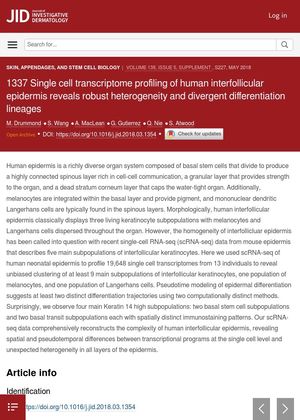Single Cell Transcriptome Profiling of Human Interfollicular Epidermis Reveals Robust Heterogeneity and Divergent Differentiation Lineages
April 2018
in “
Journal of Investigative Dermatology
”

TLDR The human skin's outer layer has more variety in cell types and development paths than previously thought.
The study conducted five years ago used single-cell RNA sequencing (scRNA-seq) to profile 19,648 single cell transcriptomes from the human neonatal epidermis of 13 individuals. The results revealed at least 9 main subpopulations of interfollicular keratinocytes, one population of melanocytes, and one population of Langerhans cells. This contradicted the previous belief of homogeneity in the interfollicular epidermis. Pseudotime modeling suggested at least two distinct differentiation trajectories. Surprisingly, four main Keratin 14 high subpopulations were observed: two basal stem cell subpopulations and two basal transit subpopulations, each with spatially distinct immunostaining patterns. This data provided a comprehensive reconstruction of the complexity of human interfollicular epidermis, revealing spatial and pseudotemporal differences between transcriptional programs at the single cell level and unexpected heterogeneity in all layers of the epidermis.
